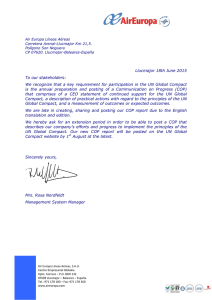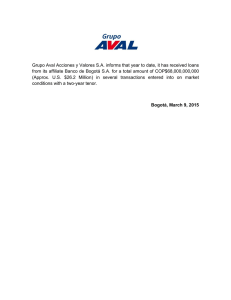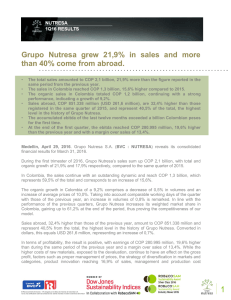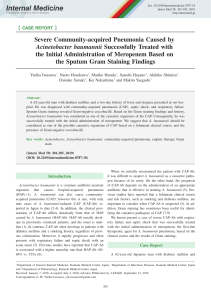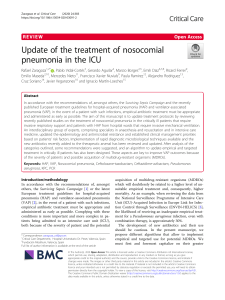CASO 5-2015:Cryptogenic organizing pneumonia.
Anuncio
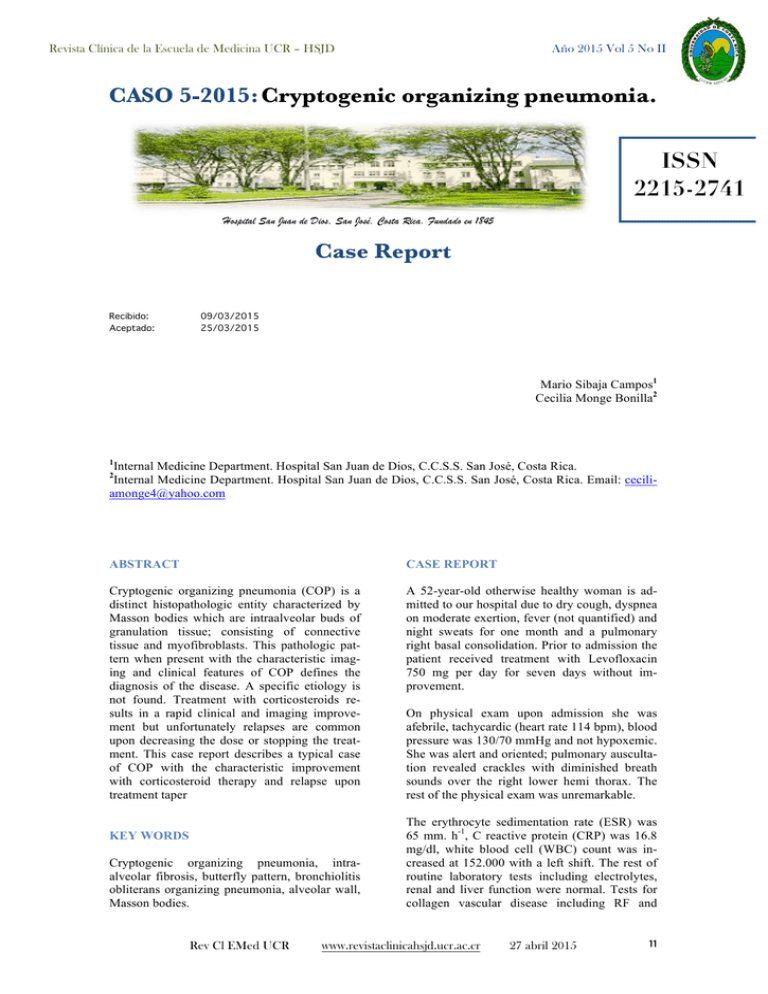
Revista Clínica de la Escuela de Medicina UCR – HSJD Año 2015 Vol 5 No II CASO 5-2015: Cryptogenic organizing pneumonia. ISSN 2215-2741 Hospital San Juan de Dios, San José, Costa Rica. Fundado en 1845 Case Report Recibido: Aceptado: 09/03/2015 25/03/2015 Mario Sibaja Campos1 Cecilia Monge Bonilla2 1 Internal Medicine Department. Hospital San Juan de Dios, C.C.S.S. San José, Costa Rica. Internal Medicine Department. Hospital San Juan de Dios, C.C.S.S. San José, Costa Rica. Email: ceciliamonge4@yahoo.com 2 ABSTRACT CASE REPORT Cryptogenic organizing pneumonia (COP) is a distinct histopathologic entity characterized by Masson bodies which are intraalveolar buds of granulation tissue; consisting of connective tissue and myofibroblasts. This pathologic pattern when present with the characteristic imaging and clinical features of COP defines the diagnosis of the disease. A specific etiology is not found. Treatment with corticosteroids results in a rapid clinical and imaging improvement but unfortunately relapses are common upon decreasing the dose or stopping the treatment. This case report describes a typical case of COP with the characteristic improvement with corticosteroid therapy and relapse upon treatment taper A 52-year-old otherwise healthy woman is admitted to our hospital due to dry cough, dyspnea on moderate exertion, fever (not quantified) and night sweats for one month and a pulmonary right basal consolidation. Prior to admission the patient received treatment with Levofloxacin 750 mg per day for seven days without improvement. KEY WORDS Cryptogenic organizing pneumonia, intraalveolar fibrosis, butterfly pattern, bronchiolitis obliterans organizing pneumonia, alveolar wall, Masson bodies. Rev Cl EMed UCR On physical exam upon admission she was afebrile, tachycardic (heart rate 114 bpm), blood pressure was 130/70 mmHg and not hypoxemic. She was alert and oriented; pulmonary auscultation revealed crackles with diminished breath sounds over the right lower hemi thorax. The rest of the physical exam was unremarkable. The erythrocyte sedimentation rate (ESR) was 65 mm. h-1, C reactive protein (CRP) was 16.8 mg/dl, white blood cell (WBC) count was increased at 152.000 with a left shift. The rest of routine laboratory tests including electrolytes, renal and liver function were normal. Tests for collagen vascular disease including RF and www.revistaclinicahsjd.ucr.ac.cr 27 abril 2015 11 Revista Clínica de la Escuela de Medicina UCR – HSJD ANA were negative. Brain natriuretic peptide (BNP) and procalcitonin were within normal limits. Cultures of bronchial aspirate for mycobacteria and serology of respiratory viruses was negative, immunoglobulin levels were normal. Año 2015 Vol 5 No II The diagnostic impression was an organized pneumonia due to the nonspecific inflammatory lymphoplasmocytic cellularity. Specimens were smear and culture negative. Cytologic analysis was normal. Pulmonary function tests showed a forced vital capacity (FVC) 64% of predicted value, forced expiratory volume in 1 sec. (VEF1) 63% pred. and FEF 25-75% 52% pred. The pathologic review of the lung specimen had revealed Masson bodies; polypoid structures consisting of fibroblasts within the alveolar ducts and bronchioles. A chronic interstitial inflammatory infiltrate was present with prominent hyperplasia of type II pneumocytes and intraalveolar macrophages (figure 2). The latter observations were consistent with the diagnosis of cryptogenic organizing pneumonia. Figure 2. Chronic interstitial inflammatory infiltrate was present with prominent hyperplasia of type II pneumocytes and intraalveolar macrophages. Figure 1. CT of the lung showed a right posterior segmentary consolidation. You can find a full video of this CT scan in: https://www.youtube.com/channel/UCgRZTxrN cN6zMkw0ih9Rkaw Computed tomography (CT) of the lung showed a right basal posterior segmentary consolidation, a pulmonary embolism was ruled out with an angio-CT (figure 1). Bronchial lavage (BAL) differential cell count revealed lymphocytosis and an increase in polymorphonuclear cells (cell count: 18.3% macrophages, 61.8% lymphocytes, 18.2% polymorphonuclear and 1.8% bronchial cells). 12 Rev Cl EMed UCR During the hospital stay the patient did not receive antibiotics. The diagnosis of cryptogenic organizing pneumonia was made but steroid treatment was not started pending the tuberculin test result (which was negative). She was discharged with ongoing pulmonary clinical symptoms. The patient was seen in the outpatient clinic two weeks after discharge and treatment with 50 mg of prednisone daily was started. She underwent the six-minute walk test (6MWT) and reached 420 mts. presenting desaturation with a pO2 62 mmHg. The DLco was 75% pred. The plethismography showed a VC of 73% pred. with normal TLC and RV values. Pulmonary function tests had a FVC 73% pred. and normal VEF1 and FEF25-75% values. The ESR was 21 mm. h-1 and CRP 0.33 mg/dl. Two months after discharge the patient was seen in the outpatient clinic. On physical exam, pul- www.revistaclinicahsjd.ucr.ac.cr 27 abril 2015 Revista Clínica de la Escuela de Medicina UCR – HSJD monary auscultation was normal. The chest xray showed a significant improvement with radiopaque lines probably due to interstitial fibrosis. CRP was 0.36 mg/dl. Pulmonary function tests were normal and on 6MWT she walked 70 m further without desaturation. Three months after discharge the patient continued asymptomatic and the dose of prednisone was reduced to 25 mg daily. Five months later she presented with a normal pulmonary exam as well as normal chest x-ray and pulmonary function tests. ESR was 65 mm. h-1, the dose of prednisone was decreased at a rate of 5 mg per week until reaching 10 mg daily. In the following year after discharge, the patient continued asymptomatic and with normal pulmonary function tests. During this period of time the dose of prednisone was reduced to 5 mg daily and eventually to 5 mg every 48 hours. One week after the decrease in dose of prednisone to 5 mg every 48 hours, the patient presents with dyspnea, cough and thoracic pain. On physical exam crackles are present on auscultation of the right upper hemi thorax. Chest x-ray shows an alveolar infiltrate in the right upper lobe (figure 3). The dose of prednisone is increased to 25 mg daily. One week later the patient is found to be asymptomatic and pulmonary auscultation is normal; ESR is 5 mm. h-1. Año 2015 Vol 5 No II veci is started with Trimethoprim- sulfamethoxazole (160 mg/800 mg) three times per week. Pulmonary CT shows diffuse laminar atelectasis prominent in the right upper lobe. Currently the patient has been asymptomatic for the last five months on prednisone 5 mg daily and continues follow up in the outpatient clinic. DISCUSSION Cryptogenic organizing pneumonia (COP) is the idiopathic form of organizing pneumonia consisting of a diffuse interstitial lung disease affecting the alveolar walls as the most important area of injury, alveolar ducts, respiratory bronchioles and distal bronchioles.(1-3) It is only considered to be cryptogenic when there is not a definite etiology of organizing pneumonia.(4) An incidence of 6 to 7 cases per 100.000 hospital inpatients was found in one study,(5) the annual incidence in other studies has been 1.1 per 100.000.(6) Pathogenesis The most interesting characteristic of COP is that it is not associated with progressive irreversible fibrosis; the fibrosis seen in COP usually has a marked reversibility with corticosteroids differentiating COP from usual interstitial pneumonia (UIP). The first stage in the process of organization of the fibrosis seen in COP consists of the formation of fibrinoid inflammatory cell clusters, which consist of inflammatory cells including polymorphonuclears, lymphocytes, mast cells and plasma cells with bands of fibrin.(7) Figure 3. Chest x-ray: alveolar infiltrate in the right upper lobe. The formation of fibroinflammatory buds (Masson bodies) is characteristic of the second stage; inflammatory cells are less numerous and fibrin is fragmented. The presence of mitotic figures is proof of the migration and proliferation of fibroblasts from the interstitium to the basal laminae and their colonization of fibrin remnants. A reepithelialisation of the basal laminae takes place because of the proliferation of alveolar cells; this reepithelialisation is vital for the preservation of the integrity of the structure of the alveolar unit.(8) In the following four months the patients continues asymptomatic. Pulmonary exam, chest xray and pulmonary function tests are normal; prednisone treatment is decreased to a dose of 5 mg per day. Prophylaxis for Pneumocystis jiro- The final stage of the process of organization is characterized by mature fibrotic buds with almost no inflammatory cells and the fibrin in the alveolar lumen has disappeared; layers of connective tissue alternate with concentric rings of fibroblasts.(9) Rev Cl EMed UCR www.revistaclinicahsjd.ucr.ac.cr 27 abril 2015 13 Revista Clínica de la Escuela de Medicina UCR – HSJD The intra-alveolar buds in COP are characterized by prominent capillarisation.(10) Intraalveolar buds express basic fibroblast growth factor and vascular endothelial growth factor.(11) These growth factors mediate angiogenesis and are important for the reversal of buds seen in COP with treatment. Clinical Features The mean age of onset of COP is 50-60 years; males and females are affected equally. Clinical manifestations include progressive mild dyspnea, cough, fever, malaise, anorexia and weight loss. Uncommon manifestations include hemoptysis, night sweats, mild arthralgia and chest pain.(12,13) Diagnosis is many times delayed because of the nonspecific manifestations. On physical exam the pulmonary exam may present focal sparse crackles or may be normal. Año 2015 Vol 5 No II Bronchioalveolar lavage (BAL) is indicated in all cases where COP is being considered as a differential diagnosis. BAL may evidence neoplastic pathologies (bronchioalveolar carcinoma or lymphoma) as well as active infections. Patients with COP characteristically present a BAL with a mixed pattern differential cell count; consisting of an increased percentage of lymphocytes (20-40%), neutrophils (approximately 10%) and eosinophils (approximately 5%); the percentage of eosinophils is characteristically lower than that of lymphocytes. The CD4/ CD8 ratio is usually low.(18,19) Blood tests may present a mild leukocytosis with a mild increase in neutrophils. Eosinophilia is not present. Erythrocyte sedimentation rate and C- reactive protein are characteristically elevated.(20) Diagnosis of COP Imaging COP has three patterns of presentation on imaging studies; solitary opacity (focal COP), multiple alveolar opacities (typical COP) and infiltrative opacities (infiltrative COP). CT images are characteristic and yield the correct diagnosis in approximately 80% of cases.(14) The most frequent imaging seen in COP consists of multiple alveolar opacities, which are mostly peripheral, bilateral and migratory. Their size varies between a complete lobe and a few centimeters; air bronchogram may be present. When patients with COP present with the typical imaging characteristics of the disease on CT scan or HRCT scan the differential diagnosis narrows down to include bronchioalveolar lung carcinoma, idiopathic chronic eosinophilic pneumonias and low-grade lymphoma.(15) Patients presenting with infiltrative or focal COP on imaging are usually diagnosed through histopathology since these patterns are not characteristic of the disease. The diagnosis of COP requires the histopathologic diagnosis of organizing pneumonia and the exclusion of any specific cause. Histopathologically the typical features of organizing pneumonia are buds of granulation tissue (Masson bodies) consisting of myofibroblasts- fibroblasts embedded in connective tissue. These buds may extend through the interalveolar pores presenting a “butterfly pattern”.(21,22) Foamy alveolar macrophages are present as well as mild interstitial inflammation. Special stains to exclude infection are usually the norm in patients being studied for possible COP. It is imperative to have enough amount of lung tissue to be able to perform a meticulous histopathologic study; because of this, video assisted thoracoscopy is usually performed in these patients to obtain lung tissue of sufficient size. However in some cases, such as the one presented here, the finding of intra alveolar buds is seen on transbronchial biopsy specimens.(23) Organizing pneumonia within a specific content Lung Function Tests On spirometry patients with COP frequently have a moderate to mild restrictive ventilatory defect. Obstructive abnormalities are not characteristic of the disease, although they may be seen in patients with underlying chronic obstructive pulmonary disease or smoking. The reduction of pulmonary restriction is proportional to the reduction of the transfer factor of the lung for carbon monoxide. Hypoxemia both with mild exertion and at rest are usually mild.(16,17) 14 Rev Cl EMed UCR Organizing pneumonia can be present as a pulmonary manifestation in patients with connective tissue disorders (dermatomyositispolymiositis, systemic lupus erythematosus, rheumatoid arthritis, CREST, scleroderma and Sjogren syndrome). It may also present with malignancies, hematological diseases and inflammatory bowel disease. These disorders must be considered and ruled out as appropriate when making the diagnosis of COP. That said, patients with COP have been reported to have articular pain without an underlying disorder.(13) www.revistaclinicahsjd.ucr.ac.cr 27 abril 2015 Revista Clínica de la Escuela de Medicina UCR – HSJD Treatment of COP presented here; this causes prolongation of treatment.(25) Treatment decisions in COP are usually based on practice guidelines since treatment of COP has not been studied in randomized clinical trials.(24) Initiation as well as choice of first line therapy is usually based on pulmonary function on presentation, the severity of clinical symptoms and the extent and severity of disease on imaging studies as well as the progression of the disease.(25) Patients with COP who have mild symptoms as well as mild abnormalities on pulmonary function tests are usually monitored every 2-3 month intervals without treatment.(26) For symptomatic patients with moderate to severe respiratory impairment glucocorticoid treatment is recommended; the equivalent of 1 mg/kg per day (maximum 100 mg daily) is given as a single dose in the morning. Prednisone is the drug of choice and the initial dose is given for up to eight weeks, if the patient shows improvement the dose is tapered to 0.5 mg/kg/day for the next six weeks and then gradually tapered to nothing as long as the patient is stable.(26) After the cessation of treatment with prednisone the patient should be followed for the next twelve months and the chest radiograph is repeated every three months during this period of time.(27) Patients with impending respiratory failure or rapidly progressive COP are treated with high dose intravenous glucocorticoid therapy (methylprednisolone 1.000 mg intravenously for five days) as the treatment of choice.(28,29) Addition of a second immunosuppressant agent is used when patients fail to respond to initial glucocorticoid therapy, have frequent recurrences (more than three) or those who have a fulminant presentation; azathioprine or cyclophosphamide are the medications of choice in these particular COP cases.(30-32) Patients who are going to receive azathioprine should undergo analysis of the enzyme thiopurine methyltransferase gene since a deficiency of this enzyme predicts those individuals with a higher risk of severe toxic events from this medication.(33) Treatment with glucocorticoids results in clinical improvement and normalization of chest imaging in a short period of time (days to weeks) in the majority of patients. Oral glucocorticoid therapy is tapered over 6 to 18 months. Relapses are seen frequently upon reducing the dose of treatment such as the relapse in the case Rev Cl EMed UCR Año 2015 Vol 5 No II REFERENCES 1. Cordier JF. Cryptogenic organising pneumonia. Eur Respir J. 2006;28:422. 2. Epler GR. Bronchiolitis obliterans organizing pneumonia. Arch Intern Med 2001;161:158. 3. Ryu JH Myers JL Swensen SJ. Bronchiolar disorders. Am J Respir Crit Care Med. 2003;168:1277. 4. Lohr RH Boland BJ Douglas WW et al. Organizing pneumonia. Features and prognosis of cryptogenic, secondary and focal variants. Arch Intern Med. 1997;157:1323-1329. 5. Alasaly K Muller N Ostrow DN et al. Cryptogenic organizing pneumonia. A report of 25 cases and a review of the literature. Medicine (Baltimore). 1995; 74:201. 6. Gudmundsson G Sveinsson O Isaksson HJ et al. Epidemiology of organising pneumonia in Iceland. Thorax 2006; 61:805. 7. Peyrol S Cordier JF Grimaud JA. Intra-alveolar fibrosis of idiopathic bronchiolitis obliterans-organizing pneumonia. Cell-matrix patterns. Am J Pathol. 1990;137:155-170. 8. Takiya C Peyrol S Cordier JF Grimaud JA. Connective matrix organization in human pulmonary firbosis. Collagen polymorphism analysis in fibrotic deposit by immunohistological methods. Virchows Arch. 1983;44:223-240. 9. Kuhn C 3rd Boldt J King TE Crouch E Vartio T McDonald JA. An immunohistochemical study of architectural remodeling and connective tissue synthesis in pulmonary fibrosis. Am Rev Respir Dis. 1989;140:1693-1703. 10. Lappi-Blanco E Kaarteenaho-Wiik R Soini Y Risteli J Paakko P. Intraluminal fibromyxoid lesions in bronchiolitis obliterans organizing pneumonia are highly capillarized. Hum Pathol. 1999;30:1192–1196. 11. Lappi-Blanco E Soini Y Kinnula V Paakko P. VEGF and bFGF are highly expressed in intraluminal fibromyxoid lesions in bronchiolitis obliterans organizing pneumonia. J Pathol 2002; 196:220–227. 12. Mroz BJ Sexauer WP Meade A Balsara G. Hemoptysis as the presenting symptom in bronchiolitis obliterans www.revistaclinicahsjd.ucr.ac.cr 27 abril 2015 15 Revista Clínica de la Escuela de Medicina UCR – HSJD 13. 14. 15. 16. 17. 18. 19. 20. 21. 22. 23. 24. 25. 16 organizing pneumonia. Chest. 1997; 111:1775–1778. Yang DG Kim KD Shin DH Choe KO Kim SK Lee WY. Idiopathic bronchiolitis obliterans with organizing pneumonia presenting with spontaneous hydropneumothorax and solitary pulmonary nodule. Respirology. 1999; 4: 267–270. Johkoh T, Muller NL, Cartier Y, et al. Idiopathic interstitial pneumonias: diagnostic accuracy of thin- section CT in 129 patients. Radiology. 1999;211: 555–560. Carrington C Addington W Goff A Madoff I Marks A Schwaber J. Chronic eosinophilic pneumonia. N Engl J Med. 1969;280:787–798. Costabel U Teschler H Schoenfeld B et al. BOOP in Europe. Chest. 1992;102: (Suppl.1):14S–20S. Bellomo R Finlay M McLaughlin P Tai E. Clinical spectrum of cryptogenic organizing pneumonitis. Thorax. 1991; 46:554–558. Costabel U Teschler H Guzman J. Bronchiolitis obliterans organizing pneumonia (BOOP): the cytological and immunocytological profile of bronchoalveolar lavage. Eur Respir J. 1992;5:791–797. Poletti V Cazzato S Minicuci N Zompatori M Burzi M Schiattone ML. The diagnostic value of broncho- alveolar lavage and transbronchial lung biopsy in cryptogenic organizing pneumonia. Eur Respir J. 1996;9:2513–2516. Nagai S Aung H Tanaka S et al. Bronchoalveolar lavage cell findings in patients with BOOP and related diseases. Chest. 1992;102: (Suppl. 1):32S–37S. Colby TV. Pathologic aspects of bronchiolitis obliterans organizing pneumonia. Chest. 1992;102(Suppl. 1): 38S–43S. Kitaichi M. Differential diagnosis of bronchiolitis obliterans organizing pneumonia. Chest. 1992;102:(Suppl. 1):44S–49S. Basset F Ferrans VJ Soler P Takemura T Fukuda Y Crystal RG. Intraluminal fibrosis in interstitial lung disorders. Am J Pathol. 1986;122: 443–461. King TE Jr. Organizing pneumonia. In: Interstitial lung disease, 5, Schwarz MI, King TE Jr. (Eds), People's Medical Publishing House, Shelton, CT 2011. p.981. Oymak FS Demirbaş HM Mavili E et al. Bronchiolitis obliterans organizing Rev Cl EMed UCR Año 2015 Vol 5 No II 26. 27. 28. 29. 30. 31. 32. 33. pneumonia. Clinical and roentgenological features in 26 cases. Respiration. 2005;72:254. Bradley B Branley HM Egan JJ et al. Interstitial lung disease guideline: the British Thoracic Society in collaboration with the Thoracic Society of Australia and New Zealand and the Irish Thoracic Society. Thorax. 2008;63 Suppl 5:v1. Lazor R Vandevenne A Pelletier A et al. Cryptogenic organizing pneumonia. Characteristics of relapses in a series of 48 patients. The Groupe d'Etudes et de Recherche sur les Maladles "Orphelines" Pulmonaires (GERM"O"P). Am J Respir Crit Care Med. 2000;162:571. Nizami IY Kissner DG Visscher DW Dubaybo BA. Idiopathic bronchiolitis obliterans with organizing pneumonia. An acute and life-threatening syndrome. Chest. 1995;108:271. Pérez de Llano LA Soilán JL García Pais MJ et al. Idiopathic bronchiolitis obliterans with organizing pneumonia presenting with adult respiratory distress syndrome. Respir Med. 1998; 92: 884. Purcell IF Bourke SJ Marshall SM. Cyclophosphamide in severe steroidresistant bronchiolitis obliterans organizing pneumonia. Respir Med 1997; 91:175. Ning-Sheng L Chun-Liang L RaySheng L. Bronchiolitis obliterans organizing pneumonia in a patient with Behçet's disease. Scand J Rheumatol. 2004;33:437. Lee YH Choi SJ Ji JD et al. Dermatomyositis without elevation of creatine kinase presented as bronchiolitis obliterans organizing pneumonia. Korean J Intern Med. 2000;15:85. Laszlo A Espolio Y Auckenthaler A et al. Azathioprine and low-dose corticosteroids for the treatment of cryptogenic organizing pneumonia in an older patient. J Am Geriatr Soc. 2003;51: 433. COMMENTS A special thank you to Alvaro Herrera Alfaro MD for his valuable contribution to the figures in this case report www.revistaclinicahsjd.ucr.ac.cr 27 abril 2015
